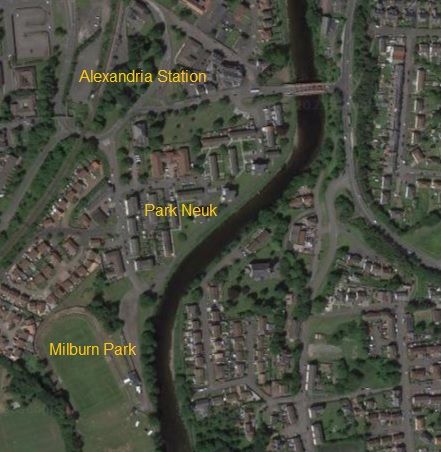Park Neuk, 1872 and
The Birth of the Working-Class Game
No-one knows when it happened exactly other than the year, 1872 and that it was late Autumn or early winter, perhaps October. But the where and what of the event are clear. It took place on Park Neuk on the banks of the River Leven that flowed then and flows still through Alexandria in Dunbartonshire. And it was the moment that working-class football was born.
That Association Football is an English invention is undoubted. It emerged as the ostensible loser from a meeting in 1863 in London's Covent Garden of football-playing private and therefore at least middle-class, often upper-class schools and clubs. The meeting was to try to hammer out some common rules. It failed. What emerged instead was a split between entities that wished to play football only with the feet and the majority, the large majority which wished for a game where use of both hands and feet was legitimate. The result was several more years of vacillation by the "handers" and the formation by the thirteen "feeters" of the Football Association, the "English" Football Association.
Equally there can be no argument that for reasons that remain largely unclear football was brought to Scotland by the Queen's Park club, formed in Glasgow in 1867 and based in the city's burgeoning southern suburbs. But Queen's Park, whilst it remained the only club playing to Association rules in Scotland, was also middle-class, middle middle-class, even perhaps a little lower middle-class and definitely not upper class, but not a place for the labourer. As such it struggled. Pure Association rules were confined to internal matches. What few external fixtures that took place were with clubs that dabbled with a version of football or where cricket was the game of choice and football of any sort a winter diversion. But here was Queen's Park's genius. To create interest and therefore opponents the club adopted a missionary policy. It went outwith to play demonstration-games.
And that is just what happened that day on Park Neuk, Alexandria's then cricket field in summer and in winter its shinty, yes shinty, field, for that was the then hibernal choice of sport for the burgeoning working population of the vale, many of whom were drawn from the neighbouring Argyll and Perthshire Highlands. Queen's Park presumably took the train to Alexandria and word has it that a game was begun between mainly young local, local sportsmen and the Glaswegians, the latter explaining the rules and mixing players as they went along.
But is was done in three contexts, two in the recent past and a second to be in the near future. The first had been the staging from November 1871 by the "English" football association of the inaugural FA Challenge Cup, the FA Cup, to which Queen's Park had been invited. The second was the probably unintentional doctoring of the competition that had allowed the Queen's Park team to have byes until the semi-finals, when in the first game it had actually played the result was an away-draw in March 1872 in London to The Wanderers. And it would be The Wanderers that would eventually take the trophy by defeating the Royal Engineers but only after Queen's Park had been unable for financial reasons to make a semi-final replay, to held once more in London, with the implication that had done so they might have reached the final and won it. And the third context was successful staging on St. Andrew's Day 1872, so 30th November, of the first ever Association Football international. Moreover it took place in Glasgow, with the expectation that Scotland, that is the Queen's Park team in Caledonian blue, would be gubbed but with it actually achieving a 0-0 draw seen by Scots at least as a victory.
Thus interest in the Association game had first been pricked and then expanded with the result that within weeks along the banks of the Dunbartonshire Leven three teams were formed by young men, who had been at Park Neuk or had heard tell of it- in Alexandria itself, Vale of Leven, Renton in the neighbouring village of the same name, and where the Leven meets the Clyde, Dumbarton. More teams followed in Glasgow but the three Leven teams were different. Their players were not soft-handed city-boys but tough workers from the dye-fields, the tanneries, the mills and the ship-yards that lined the river and the shore, providing them their gritty living. They were in no way bourgeois but provincial proletariat, who would soon apply a distinctive approach based on their fitness from manual labour, innovative tactics in part from shinty and, indeed, from their Scottish-ness to the new game in toon, changing it forever and eventually for everyone worldwide not once but twice.
And where is Park Neuk now. It is under a neat, wee housing estate just a stone's throw from Alexandria's train station and Vale of Leven's, its direct product's current ground at Milburn Park. Visit it as part of the Leven Trail and see where the game, the beautiful, universal game that is, if not by birth then upbringing, essentially Scots and enjoyed today by youse and millions of others, really started. Leven not London.
